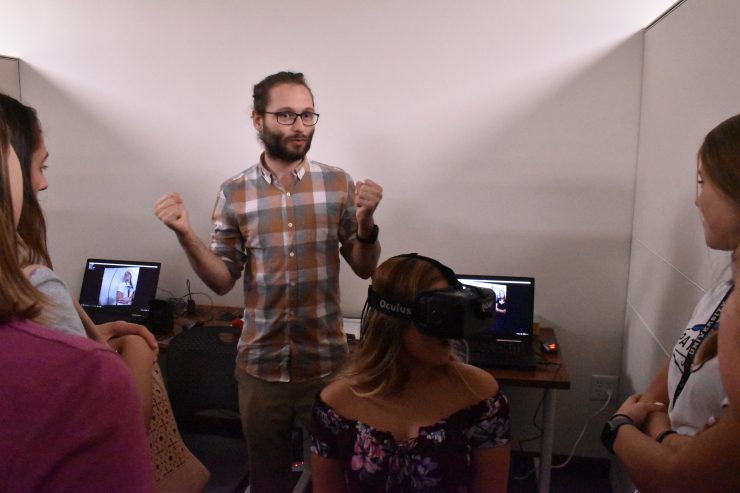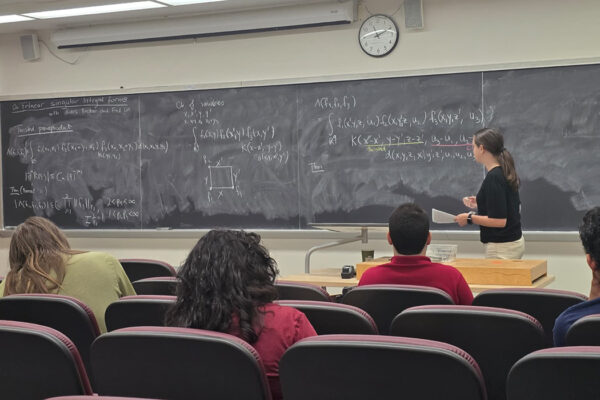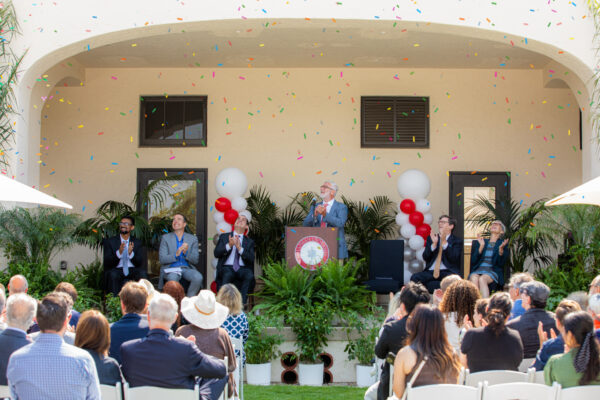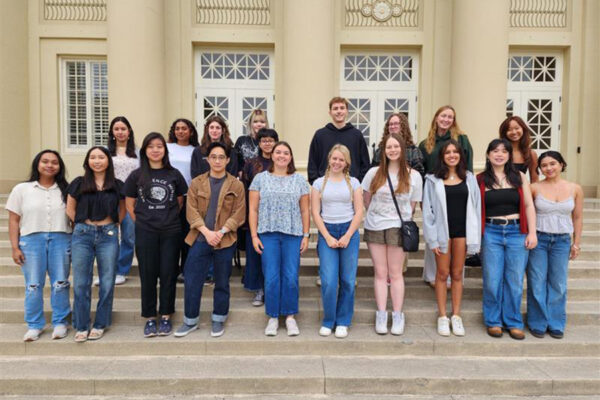When your research project invites colleagues to think anew about questions that have been debated for centuries, you learn to welcome the unexpected. Like when you get a call out of the blue from a scholar who says he’s phoning from Chapman.
“In Canada, Chapman is a popular brand of ice cream. So at first I thought I might be asked for a corporate sponsorship to consider the neuro-coordinates of vanilla, chocolate and the human brain,” recalls a smiling Amir Raz, Ph.D., then a professor at McGill University in Montreal.
Instead, the voice on the other end belonged to Chapman University President Daniele Struppa, who started a conversation that would eventually lead to Chapman becoming a world-leading hub of brain science inquiry: a place to bring the most challenging questions in psychology and neuroscience; to test theories on consciousness and free will; to expand a collaborative spirit by welcoming even more scholars and disciplines.
Vanilla or chocolate? No, the questions at the heart of this research have much more sustenance and nuance. How does the brain give rise to the conscious mind? Are humans endowed with conscious free will? Do we control our actions, or are we the ones being controlled?
“Sometimes it translates into decision-making, and sometimes into cognition, but when it comes to free will, a lot of it has to do with core human experience. It’s about trying to understand whether I own my actions,” says Raz, now director of the new Institute for Interdisciplinary Brain and Behavioral Sciences – the Brain Institute at Chapman.
“Was I planning my actions, or was something happening to me against my will? Was I influenced, or did I influence the actions? These are not just philosophical questions, and they’re not just legal questions,” Raz adds.“They have an air of importance for our human identity.”
$7 Million in Research Support
The Brain Institute’s ambitious research program is validated by the more than $7 million in funding it has attracted, including $5.34 million from the John Templeton Foundation and $1.55 million from the Fetzer Institute. With an additional $150,000 coming from the Fetzer Memorial Trust, the funding total of $7.04 million represents Chapman’s largest non-federal research grant to date.
“The grant aims to create a new field in the study of the brain – the neurophilosophy of free will,” says Uri Maoz, Ph.D., assistant professor of computational neuroscience at Chapman and the leader of the project. “We are not just a center of the study of the neuroscience of free will – we are the center.”

Chapman’s leadership in the field was evident during a conference in March that served as the institute’s coming-out party. The International Conference on the Neuroscience of Free Will attracted 90 researchers from 40 universities to Chapman’s Rinker Health Science campus in Irvine, where the Brain Institute makes its home. The institute also has offices on the Orange campus.
As the Brain Institute research program ramps up, Chapman will be at the center of inquiry involving 17 universities spanning four continents. Included are Harvard, Yale, NYU, Duke, UCLA, University College London, Charité Berlin, Tel Aviv University and Monash University in Australia.
“The neuroscience and philosophy of free will – it all comes together at Chapman,” said Maoz, a psychologist and computational neuroscientist who came to Chapman from UCLA.
“I don’t claim that no research has been done about this before, but what I’m trying to do is to bring people together more formally and try to think what a field requires,” Maoz notes in a recent interview in Science magazine. “It requires conferences, for example, where people come together from time to time to talk specifically about the topic, instead of meeting at the sidelines of another conference, on vision or decision-making or consciousness, to talk about free will. We try to think of ways to get students engaged, as equal partners. … We need to get younger people excited about this.”
Undergrad Research
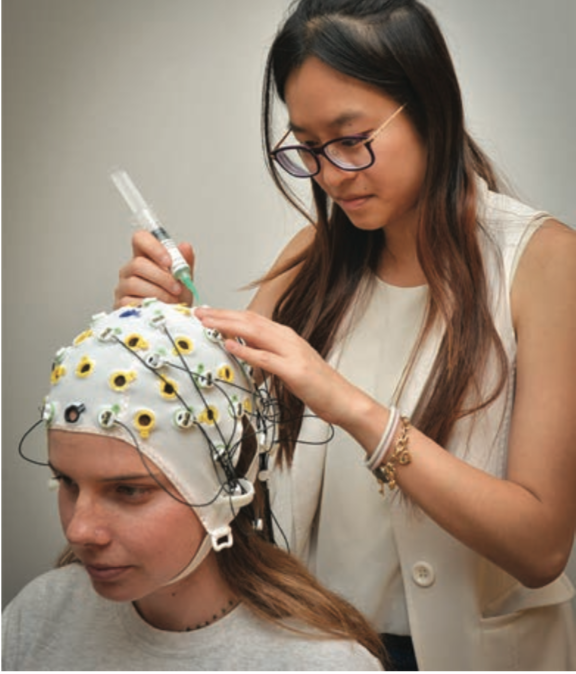
Cristina Uribe ’22 is certainly excited. Last semester, as a first-year student at Chapman, she took a class in consciousness and was hooked by the study of brain science. Six months later, she is implementing a research project at the Brain Institute, and she has founded the student Brain Club at the University.
None of this is a stretch for Uribe, a native of Colombia who grew up in Panama and who had her earliest thoughts about consciousness and the brain when she was just 6 years old.
“I remember it perfectly,” she says. “I was in the park, and I saw this red swing. I thought, ‘What is red? Do we all see it the same way, or do we just all call it red?’ That shaped me.”
Later, Uribe saw a therapy based on research change the life of her sister, who had been diagnosed with a case of ADHD so severe it was expected to severely limit her opportunities throughout her life.
“It turned out that she just experienced things differently,” Uribe says of her sister. “For her, being touched was like her skin was covered in painful blisters, and she reacted aggressively. Sensory integration therapy helped her adapt to the real world. She ended up graduating at the top or her class at Northeastern, and now she’s working at Amazon.”
These days, Uribe is conducting a Brain Institute research experiment called the rubber-hand illusion. Participants watch a dummy hand being stroked by a paint brush while identical strokes are applied to their real hand, which is hidden from view. Sometimes the feeling of touch can come without any tactile stimulation, just by seeing the rubber hand receive brush strokes.
“Even though the stimulus is the same, what you pay attention to will create the perception,” Uribe says. “This indicates it’s a top-down sensation, not a bottom-up one, which had previously been shown. That tells us more about consciousness. Even though the outside world is the same, if you are thinking differently, it shapes how you see the world.”
In her first year of college, Uribe is scheduling experimenters, recruiting participants and collecting data. “I never thought I could do research like this as a freshman,” she says.“I find it amazing.”
The research project could eventually inform treatments for amputees experiencing phantom limb syndrome. But for now Uribe’s focus is on collecting results, not applying them.
“We’re just beginning,” she says. “We have to see.”
Do Humans Have Free Will?
Uribe’s experiment is just one of many underway at the Brain Institute. Other projects include human random sequence generation and neurofeedback. Still others incorporate a driving simulator and a sensory-deprivation tank.
One experiment – metacognition in deliberate and arbitrary choices – explores how the timing of people’s judgment about their actions and intentions changes across the types of decisions being made. This experiment builds on the groundbreaking work done by physiologist Benjamin Libet in the 1980s. Libet found that the brain signaled a physical action before participants reported that they had even decided to move. It’s seen as the moment when neuroscience entered a realm that had been reserved for philosophy: Do humans have free will?
“Libet’s study was the paper that spawned a thousand papers and launched the field,” Maoz says in the Science magazine piece. “But there was a lot of criticism against Libet’s findings. I think what individual scientists have done since was to try to chip away some of the criticism. They tried to answer questions such as does brain activity only predict when you are going to move a hand, or could it predict which hand you move? How early can you see the signal? Do these early predictive signals mean the decision has been made several seconds in advance? Or are they some kind of activity that biases the decision? So, I’d say two types of progress have been made. One is that we tried to elucidate which of the claims made in the original paper holds, what replicates and what doesn’t. Second, we now know the question is much more complex and nuanced. That’s one of the reasons we need our philosopher colleagues. They have been thinking about [free will] for many years.”
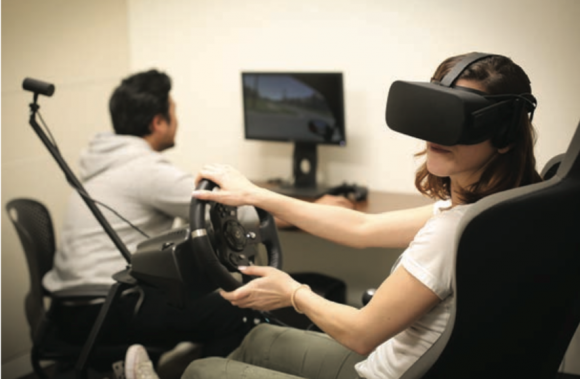
Indeed, it’s time to make the consideration of consciousness and free will a team sport, says Aaron Schurger, Ph.D., assistant professor of psychology and the third member of the Brain Institute faculty leadership team.
“The only way we’re going to solve this is if our communities work together, including social scientists, biologists, mathematicians, engineers, computer scientists and statisticians,” says Schurger, who came to Chapman from the French National Institute for Health and Medical Research as well as the Neurospin Research Center in France. “In our mission to be the best in the world, we certainly aren’t playing it safe.”
